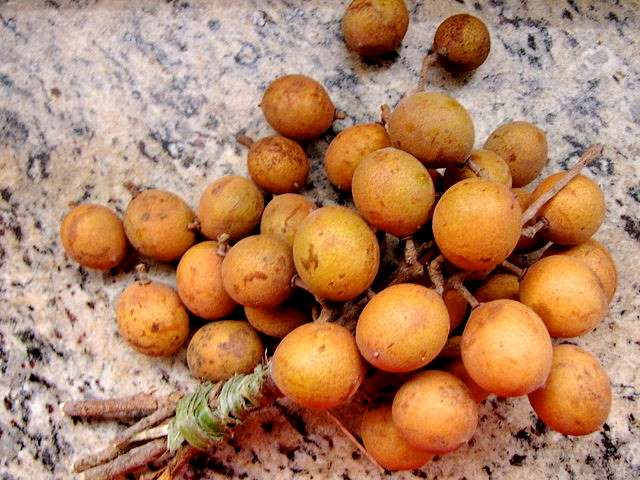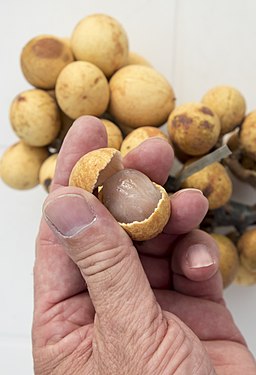
The Pitomba (Thalisia esculenta A.St. Hil Radlk) is an Amazonian fruit also known as ojo de buey, pitomba da mata, pitomba monkey and caruiri, which belongs to the family Sapindaceae, genus Talisia and species T. esculenta (Food and Agriculture Organization of the United Nations, FAO, 1987).
Where is Pitomba grown?
It is a native species of the southern Brazilian Amazon, most frequently found in the Caatinga, Cerrado and Atlantic Forest biomes, as well as in Bolivia, Peru and Paraguay (Santos et al., cited by Nascimento and Montezano, 2020).
Eugenia luschnathiana Klotzsch ex O.Berg. (syn. Phyllocalyx luschnathianus Berg.), on the other hand, is known as Pitomba-da-bahia and is also called in Brazil uvalha do campo, ubaid do campo, or uvalheira.
Pitomba cultivation
Propagation of T. esculenta is exclusively by seed. It is considered an exotic fruit, obtained from the extractive harvest of the tree that produces it.
Located in Amazonian and Atlantic rainforest forests as well as in small orchards throughout Brazil; it has also become established in semi-arid areas (Costa, 2019).
The tree of this fruit called Pitombeira, with thick bark and brown color, can reach a height between 6 and 12 meters, whose trunk diameter varies between 30 and 40 cm (Vieira and Gusmão, cited by Nascimento and Montezano, 2020).
It contributes to the recovery of degraded areas, as it is a source of food for numerous species of birds; it is also often used for tree planting in squares and parks (FAO, 1987).
Flowering occurs from August to October and the fruit ripening process takes place from January to March (Guarim-Neto, cited by Nascimento and Montezano, 2020).
Description of Pitomba fruit
Pitomba is a subglobular or ovoid berry of about 3 cm in diameter, with a thick and brittle shell or exocarp, with a green-yellow color that turns dark orange-golden when ripe.
Its pulp has a fleshy texture, white and translucent, covering one or two large, oblong and white seeds.
It has a sweet, slightly acid taste (Ecured, 2020). The fruits grow in bunches of 10 to 25 units and are harvested in this form to be sold in the market (FAO, 1987).
Pitomba pulp represents only 15.4% of the fruit weight, while 40.0% of it corresponds to the seed and the remaining 44.6% is shell (Costa, 2019).

Bdioeu CCBY 3.0
This discourages the commercialization of the fruit due to its low utilization. Therefore, it is interesting to study the composition and properties of the bark as a source of nutrients and beneficial health effects.
Pitomba Nutrients
Pitomba contains protein, calcium, phosphorus, iron, vitamin A, vitamin B1, vitamin B2 and vitamin C (Agronews, 2020).
In recent research, Nascimento and Montezano identified, in turn, that Pitomba bark contains vitamin C, minerals and antioxidant properties.
However, vitamin C is more present in the pulp of this fruit: 200.68 mg per 100 grams of pulp, while the peel contains 128.34 mg per 100 grams.
For comparison, orange contains 53.7 mg/100 grams of edible part, according to the Brazilian Table of Food Composition (Costa, 2019).
Use and properties of Pitomba(Talisia esculenta)
This fruit, found mainly in the north and northeast of Brazil, is harvested from orchards or purchased in the market.
The peel is opened and the pulp is eaten, discarding the outer cover of the fruit and the seeds. According to FAO (1987), the latter are very astringent and when boiled are used in case of diarrhea.
Pitomba is used as a fresh fruit; the fleshy and whitish part of the fruit called aril is eaten, which can also be used to prepare juice or juice, jam, salad dressing, liquor and some preparations based on creativity and innovation (Ecured, 2020).
Benefits of Pitomba
The fruit and especially the peel have favorable health effects: it protects the cardiovascular system; strengthens the immune system; fights anemia by contributing to the formation of hemoglobin; strengthens bones and prevents osteoporosis.

Jonathan Wilkins / CC BY-SA
It also favors glandular function, especially suprarenal; it helps to disinfect wounds and improves wound healing, given its astringent action; it acts as a powerful antioxidant fighting free radicals, thus preventing cell degeneration.
It also helps prevent cancer and Alzheimer’s; prevents skin aging and is very effective in capillary health; improves intestinal problems and is anti-diarrheal (Costa, 2019; Dietafitness, 2020).
Agroindustrial uses of Pitomba husks
Moreover, Pitomba leaves are used to prevent the leather from rotting, due to the presence of tannins.
A protein present in this fruit is also used to combat fungi and insects in sugarcane and coffee plantations (Agronews, 2020).
Finally, in some regions of Brazil it is common to use the expression “not even worth a Pitomba”, to say that it is not worth anything.
Pitomba also gives its name to a religious festival in Pernambuco, in Jaboatão dos Guararapes, located in northeastern Brazil, since it coincides with the fruit’s harvest period (Pimentel, 2020).
However, in many parts of this country and the world, few people are familiar with this Amazonian fruit.
Bibliography
- Agronews. Pitomba 2.0: saiba tudo sobre esta excelente fonte de saúde (21 de fevereiro de 2020), retrieved from http://www. agronewsbrazil.com.br.
- Costa, M. Pitomba bark properties may even prevent disease (February 12, 2019), retrieved from http://www.ciencia.ufs.br.
- Dietafitness. 2020. Pitomba, the Amazon fruit, retrieved from http://www.dietafitness.es.
- Ecured. 2020. Pitomba, recovered from http://www.ecured.cu.
- Nascimento, L. and Montezano, M. 2020. Thalisia esculenta (A. ST.-HIL.) Radlk: physico-chemical characteristics, antioxidant activity and biological activity, Research, Society and Development, vol. 9, (2), pp. s/n. (PDF).
- Food and Agriculture Organization of the United Nations, FAO. 1987. Forest species that produce fruits and other foods. Examples from Latin America. Rome: FAO.
- Pimentel, M. 2020. Benefícios da Pitomba, retrieved from http://www.fruta.com.br.

Economist (Central University of Venezuela). Full professor and researcher attached to the “Edgar Abreu Olivo” Agrifood Research Center, Universidad de Los Andes. Doctor from the University of La Laguna (Spain). Award “One of the 10 most consulted authors of the Saber ULA university portal” (2005); prize in the III Essay Contest of the Central Bank of Venezuela BCvoz Economico, 2016, with the work “Theobroma cacao: transformation and consumption of the “food of the gods” in Venezuela and the world” (co-authored).
This post is also available in:
![]() Español (Spanish)
Español (Spanish)
